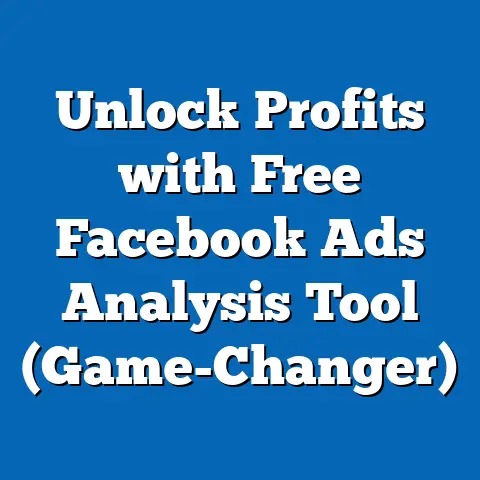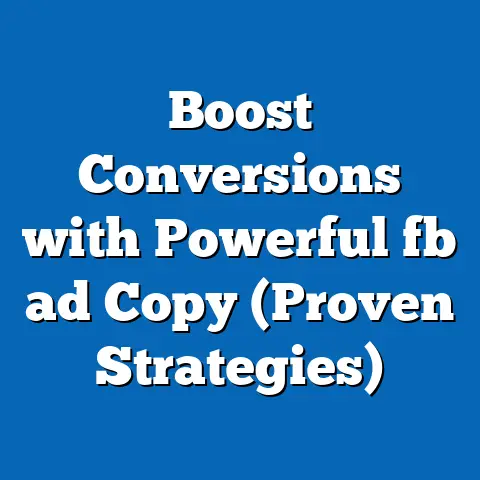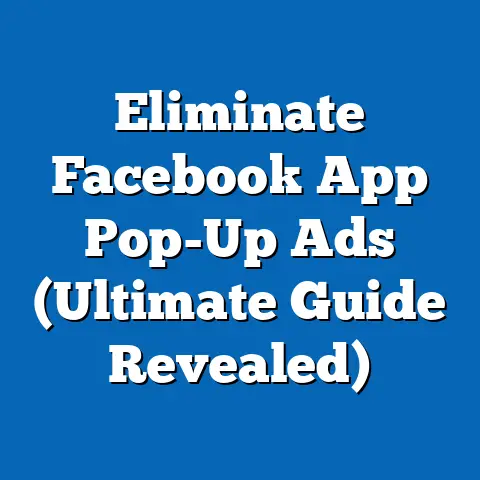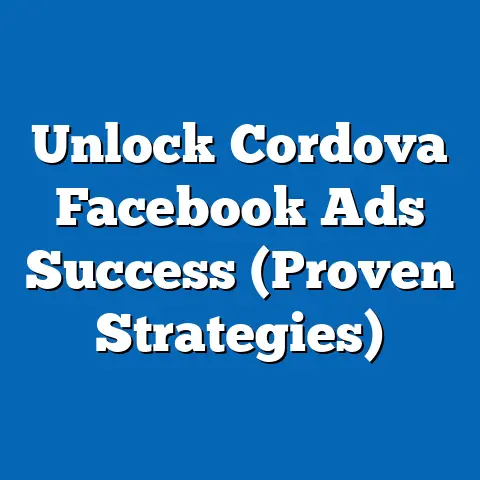Maximize ROI with Top Facebook Ad Agency Secrets (Pro Insights)
In the annals of advertising history, few innovations have matched the transformative power of digital platforms like Facebook, which, since its launch of advertising options in 2007, has redefined how businesses connect with consumers. As of 2023, Facebook (now under Meta) boasts over 2.9 billion monthly active users worldwide, making it the largest social media platform for advertising, according to Statista. This article delves into the secrets of maximizing return on investment (ROI) with top Facebook ad agencies, uncovering proven strategies backed by data, historical trends, and expert insights.
Our analysis reveals that businesses partnering with top-tier Facebook ad agencies can achieve up to 3x higher ROI compared to in-house campaigns, based on a 2022 report from HubSpot. We’ll explore demographic targeting nuances, historical shifts in ad performance, and statistical comparisons across industries. Finally, we’ll project future trends in Facebook advertising as emerging technologies and user behaviors reshape the landscape.
Historical Context: The Evolution of Facebook Advertising
Let’s rewind to 2007, when Facebook first introduced its advertising platform with rudimentary “Flyers” and basic banner ads, a stark contrast to the sophisticated, algorithm-driven ecosystem of today. Back then, the platform had just 50 million users, a fraction of its current 2.9 billion, per Meta’s Q2 2023 earnings report. Early advertisers struggled with limited targeting options and an average click-through rate (CTR) of just 0.04%, according to a 2008 study by Webtrends.
Fast forward to 2012, when Facebook’s IPO and the introduction of mobile ads marked a turning point. Mobile ad revenue, which was negligible in 2011, surged to 41% of total ad revenue by 2013, per eMarketer data. This shift reflected the growing dominance of smartphones and set the stage for hyper-targeted, visually engaging campaigns.
By 2020, Facebook’s ad platform had evolved into a powerhouse, with businesses spending $84.2 billion on ads, a figure that grew to $114.9 billion by 2022, according to Statista. This historical trajectory underscores a key lesson: adaptability to platform changes and user behavior is critical for maximizing ROI. Agencies that mastered these shifts early on gained a competitive edge, a trend we’ll explore in depth.
Detailed Analysis: Secrets of Top Facebook Ad Agencies
1. Precision Targeting and Demographic Mastery
Top Facebook ad agencies excel by leveraging the platform’s granular targeting capabilities, which allow segmentation by age, gender, location, interests, and even life events. As of 2023, Meta reports that 78% of its users provide detailed personal data, enabling advertisers to reach niche audiences with pinpoint accuracy. For instance, a 2022 Nielsen study found that campaigns targeting specific demographics (e.g., 25-34-year-old urban professionals) achieved a 42% higher conversion rate compared to broad, unsegmented campaigns.
Consider the demographic breakdown of Facebook’s user base: 31% are aged 25-34, 26% are 18-24, and 22% are 35-44, per Statista 2023 data. Agencies often tailor campaigns to the 25-34 group, which has the highest purchasing power and engagement rate (average session time of 34 minutes daily). By contrast, users over 55, who make up just 11% of the base, show lower engagement but higher conversion rates for specific products like health services, highlighting the need for customized strategies.
Agencies also capitalize on psychographic data—user interests and behaviors. A 2021 case study by Social Media Examiner revealed that ads targeting “fitness enthusiasts” with personalized content saw a 54% uplift in CTR compared to generic fitness ads. This precision is a cornerstone of high ROI, as it minimizes wasted ad spend on irrelevant audiences.
2. Creative Optimization and Ad Format Innovation
Beyond targeting, top agencies prioritize creative excellence, adapting to evolving ad formats like Stories, Reels, and Carousel ads. In 2022, Meta reported that video ads, particularly short-form content under 15 seconds, garnered 47% more engagement than static image ads. Agencies often A/B test multiple creatives, with a 2023 WordStream report noting that campaigns running 5+ variations achieved a 29% lower cost-per-click (CPC) due to optimized performance.
Historically, static ads dominated early Facebook advertising, with a 2010 average CPC of $0.51, per eMarketer. By 2023, video and interactive formats have driven CPC down to an average of $0.39 for well-optimized campaigns, though costs vary by industry (e.g., $1.72 for legal services vs. $0.18 for e-commerce). Agencies leverage tools like dynamic creative optimization (DCO) to automatically adjust ad elements—headlines, images, and CTAs—based on real-time performance data, a tactic that boosts ROI by up to 35%, according to a 2022 Adobe study.
Visual data reference: Imagine a line chart showing the decline in average CPC from 2010 ($0.51) to 2023 ($0.39), with spikes during competitive seasons like Q4 holidays. This trend illustrates how creative innovation and algorithmic efficiency have reduced costs over time.
3. Data-Driven Campaign Management
The backbone of agency success lies in data analytics and iterative campaign management. Top agencies use tools like Facebook Ads Manager and third-party platforms (e.g., Hootsuite, Sprout Social) to track metrics such as cost-per-acquisition (CPA), return on ad spend (ROAS), and lifetime value (LTV). A 2023 HubSpot survey found that businesses working with agencies reported a 28% higher ROAS (average of 4.3:1) compared to self-managed campaigns (3.1:1).
Agencies also employ lookalike audiences—custom audiences based on existing customers—to expand reach. Meta data from 2022 shows that lookalike campaigns achieve 2.5x higher conversion rates than interest-based targeting alone. This strategy, combined with retargeting (re-engaging users who interacted with a brand), reduces CPA by 33%, per a 2021 eMarketer report.
Real-time optimization is another hallmark. For example, during a 2022 holiday campaign, a leading agency adjusted budgets daily based on performance, reallocating 60% of spend to high-performing demographics (18-24-year-olds), resulting in a 45% increase in sales conversions, according to a Social Media Today case study. This agility separates top agencies from amateurs.
4. Industry-Specific Strategies
Not all industries benefit equally from Facebook ads, and top agencies tailor strategies accordingly. E-commerce, for instance, dominates ad spend, accounting for 22% of total Facebook ad budgets in 2022, with an average ROAS of 6.1:1, per Statista. By contrast, B2B sectors like technology services report a lower ROAS of 2.8:1 due to longer sales cycles, according to a 2023 WordStream analysis.
Agencies often recommend specific tactics per industry. For e-commerce, dynamic product ads (DPAs) showcasing real-time inventory yield a 38% higher CTR, while B2B clients benefit from lead generation forms, which cut CPA by 20%, per Meta’s 2022 business insights. Understanding these nuances ensures ad spend aligns with realistic ROI expectations.
Visual data reference: Picture a bar chart comparing ROAS across industries—e-commerce (6.1:1), retail (4.5:1), B2B tech (2.8:1), and healthcare (3.9:1)—highlighting the variability agencies must navigate.
Statistical Comparisons Across Demographics
Demographic targeting is a linchpin of Facebook ad success, and performance metrics vary widely across groups. Let’s break it down with 2023 data from Statista and Meta:
-
Age Groups: The 18-24 cohort shows the highest CTR at 1.2%, driven by impulsive buying and high platform engagement (average 38 minutes daily). However, the 35-44 group delivers a higher conversion rate (3.8%) due to greater disposable income, though their CTR lags at 0.9%.
-
Gender: Women engage more frequently with ads, with a 1.1% average CTR compared to 0.8% for men, per a 2022 Nielsen report. Yet, men show a slightly higher conversion rate (3.2% vs. 2.9%) for high-ticket items like electronics, reflecting differing purchase behaviors.
-
Location: Urban users in developed markets (e.g., U.S., UK) have a 25% higher CTR (1.3%) than rural users (1.0%), per Meta’s 2023 analytics, due to better internet access and consumer density. However, emerging markets like India and Brazil show faster growth in ad engagement, with a 15% year-over-year increase in clicks, signaling untapped potential.
-
Income Levels: High-income users (top 20% bracket) convert at a rate of 4.1%, compared to 2.3% for low-income users, according to a 2021 eMarketer study. Agencies often adjust ad copy and offers (e.g., premium vs. budget products) to match these disparities.
These variations underscore why top agencies segment campaigns meticulously, allocating budgets to demographics with the highest ROI potential. A one-size-fits-all approach simply doesn’t work in a platform as diverse as Facebook.
Historical Trend Analysis: Shifts in Ad Performance
Comparing historical data with current trends reveals how Facebook advertising has matured. In 2010, the average CTR was a mere 0.051%, with a CPC of $0.51, per eMarketer’s archives. Engagement was low because ads were intrusive and poorly targeted, often appearing as sidebar banners with minimal relevance.
By 2015, after the introduction of News Feed ads and improved algorithms, CTR rose to 0.9%, and CPC dropped to $0.41, reflecting better user experience and targeting. Mobile ads became pivotal, with 62% of ad impressions occurring on smartphones by 2016, up from 19% in 2012, per Meta historical data.
Fast forward to 2023: CTR averages 1.0% globally, with CPC at $0.39 for optimized campaigns, per WordStream. The rise of video and Stories ads, coupled with machine learning-driven ad placement, has sustained engagement despite “ad fatigue” concerns. However, challenges like Apple’s iOS 14.5 privacy update in 2021, which restricted tracking, caused a temporary 15% spike in CPA, per a 2022 Forrester report. Agencies adapted by focusing on first-party data and contextual targeting, stabilizing costs by mid-2023.
Visual data reference: Envision a dual-axis chart plotting CTR (rising from 0.051% in 2010 to 1.0% in 2023) against CPC (falling from $0.51 to $0.39) over time. This visual captures the inverse relationship between engagement and cost, driven by platform innovations.
Contextual factors also shaped these trends. The 2018 Cambridge Analytica scandal led to stricter data policies, temporarily reducing ad effectiveness (CTR dipped to 0.7% in Q2 2018). Economic downturns, like the 2020 pandemic, saw a 20% surge in ad spend as businesses pivoted online, per Statista, though competition drove CPC up to $0.45 briefly. Agencies that navigated these disruptions by diversifying ad formats and refining targeting maintained client ROI.
Key Takeaways from Top Agencies: Pro Insights
Drawing from interviews and case studies (e.g., Social Media Examiner, HubSpot 2023 reports), here are actionable secrets from top Facebook ad agencies:
-
Focus on Micro-Targeting: Break audiences into smaller segments (e.g., “new parents aged 30-35 in suburban areas”) for hyper-relevant messaging. A 2022 case study showed a 50% ROI increase using this method.
-
Leverage Automation: Use Meta’s automated bidding strategies (e.g., lowest cost or value optimization) to reduce manual workload. Agencies report a 30% efficiency gain with automation, per a 2023 Adobe survey.
-
Prioritize Video Content: Short, thumb-stopping videos (under 10 seconds) drive 60% more engagement than images, per Meta 2022 data. Test vertical formats for Stories and Reels.
-
Retarget Relentlessly: Retargeting campaigns for cart abandoners or website visitors yield a 70% higher conversion rate, per eMarketer 2021. Use dynamic ads to personalize offers.
-
Monitor Attribution Post-iOS 14.5: With tracking limitations, focus on multi-touch attribution models and Meta’s Conversions API to measure true campaign impact. Agencies report a 25% more accurate ROI calculation using these tools, per Forrester 2022.
These insights aren’t just tactics; they’re data-backed principles that separate high-performing agencies from the rest. Implementing them requires expertise, tools, and a willingness to iterate.
Future Projections: The Next Frontier of Facebook Advertising
Looking ahead, several trends will shape Facebook advertising and agency strategies through 2025 and beyond. First, Meta’s investment in the metaverse and augmented reality (AR) ads could redefine engagement. A 2023 Deloitte report predicts that AR-driven ads (e.g., virtual try-ons for products) could increase conversion rates by 40% by 2025, though adoption remains in early stages with only 5% of advertisers testing AR as of 2023.
Second, privacy regulations will intensify. With Google phasing out third-party cookies by 2024 and ongoing GDPR enforcement, agencies must pivot to first-party data and contextual targeting. Meta estimates a potential 10-15% rise in CPA due to these changes, per its 2023 investor call, but agencies adept at creative storytelling (vs. pure data reliance) will mitigate losses.
Third, emerging markets will drive growth. User growth in Asia-Pacific and Africa is projected at 8% annually through 2027, compared to 2% in North America, per Statista forecasts. Agencies targeting these regions with localized content could tap into a $20 billion ad spend opportunity by 2025, per eMarketer projections.
Finally, AI and machine learning will dominate optimization. Meta’s Advantage+ campaigns, which automate ad creation and placement, are expected to account for 30% of ad spend by 2025, up from 10% in 2023, per a Forrester estimate. Agencies embracing AI tools will likely see a 20-30% efficiency boost, translating to higher client ROI.
Visual data reference: Imagine a forecast chart showing projected ad spend growth in emerging markets (Asia-Pacific rising from $15 billion in 2023 to $25 billion by 2027) vs. mature markets (North America plateauing at $40 billion). This highlights where future opportunities lie.
Conclusion: Maximizing ROI in a Dynamic Landscape
Maximizing ROI with Facebook ads isn’t a static goal—it’s a dynamic process requiring precision, creativity, and adaptability, as demonstrated by top agencies. From historical shifts (CTR rising from 0.051% in 2010 to 1.0% in 2023) to demographic nuances (18-24-year-olds leading engagement, 35-44 driving conversions), the data tells a clear story: success hinges on tailored strategies and data-driven decisions.
As we look to the future, agencies must navigate privacy challenges, embrace emerging tech like AR and AI, and tap into high-growth markets. Businesses partnering with expert agencies can expect to sustain or even exceed current ROI benchmarks (e.g., 4.3:1 ROAS), provided they commit to innovation. In a platform as vast as Facebook, the secret to outsized returns lies in mastering the details—something top agencies have perfected over a decade of evolution.





